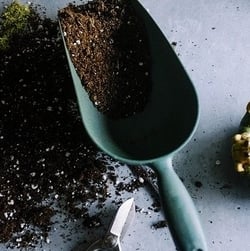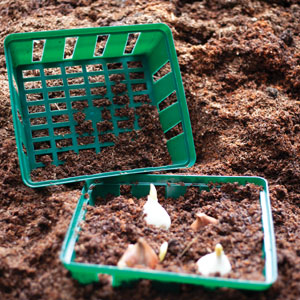Spring Bulb Growing Guide

Spring-flowering bulbs are truly a joy, cheerfully signalling the end of winter with vibrant blooms in a dazzling array of colours, shapes and sizes. While the new shoots may seem to appear overnight, preparation actually begins well in advance of the flowering season, both for gardeners and for the plants themselves.
Here, we’ll guide you through the yearly cycle of spring bulbs and share tips for getting the most out of these beauties.
Yearly cycle of a bulb
The best time to plant bulbs for spring is in mid to late autumn. After planting, the bulbs will begin to develop roots, which they use to take in nutrients from the soil. Over winter, the bulbs undergo many changes, and by the time spring rolls around, they’re beginning to send up flowering shoots.
 Because bulb plants grow above ground only for a limited time each year, they must take in essential nutrients from the sun during this window. The post-flowering phase is therefore an important time for bulb care. After blooming finishes, bulbs will take in energy for next year’s flowers via their leaves. This is a good time for feeding the plants.
Because bulb plants grow above ground only for a limited time each year, they must take in essential nutrients from the sun during this window. The post-flowering phase is therefore an important time for bulb care. After blooming finishes, bulbs will take in energy for next year’s flowers via their leaves. This is a good time for feeding the plants.
By the time the leaves have died off, the bulbs will have sufficient nutrients stored to go into dormancy. Many bulbs are happiest left to their own devices during this phase – low-maintenance gardeners rejoice! That said, dormant bulbs can sometimes run the risk of rotting, especially if the climate is warmer or wetter than in their natural habitat. Australian summers can be a particular problem in this respect.
This is because most spring bulbs favour dry conditions during dormancy, and they may not have ideal conditions if they share a bed with other perennials that require irrigation throughout summer. Dormant bulbs are also a target for pests.
For these reasons, spring bulbs are often lifted (dug up) and stored over the hottest months. This also provides an opportunity to separate clumps of bulbs that are becoming too large, which generally needs to be done every few years for optimal flowering. Preparing bulbs for storage is not too difficult, and can be made even simpler by using bulb baskets.
When the weather starts cooling down in autumn, the whole cycle starts over again with the new planting season.
Spring bulb care by month
January
- Bulbs that have been lifted should be stored in a cool dry spot. Ensure critters like rats, mice and possums cannot access them, as bulbs are a tasty treat for these animals.
- If you have pre-ordered from Garden Express, keep an eye on your mail delivery, as bulbs will be sent out soon.
February and March
- Prepare garden beds for planting, dig in plenty of compost and remove weeds. Mulch beds to reduce weed growth.
- Garden Express pre-orders should be arriving this month. On arrival, unpack bulbs and store with bags open in a cool, dry, airy position.
 April
April
- Once the soil has cooled down, you can start planting daffodil and jonquil bulbs.
- Plant bulbs like freesias, soldier boys (Lachenalia), narcissus, hyacinths and Dutch iris.
- Tulip bulbs can be put in the crisper of your fridge for 4-6 weeks to build up their strength. Do not refrigerate for any longer than 6-8 weeks.
May
- If you had tulip bulbs in the fridge, plant these now.
- Plant anemones and ranunculi (plant their claws downwards).
June
- Keep garden beds weed free.
- Some plants may be emerging now. Be patient if there are no signs of any growth, there may be lots happening under the ground.
- All spring flowering bulbs should be in the ground by now – this is your last chance to ensure a display for spring. Note that most bulbs do not store for extended periods, and must go in the ground in order to continue their life cycle.
July
- Early flowering daffodils are looking good.
- Keep an eye out for slugs and snails that can damage flower buds and leaves.
- Anemone and ranunculus may be starting their show. Ensure growth through spring by feeding fortnightly with a liquid fertiliser.
August, September and October
- Most bulbs are in flower, with September typically giving the most wonderful display. Make sure you take the time to appreciate their beauty and admire the results of your work.
- Deadhead old flowers as they fade, and feed with a complete fertiliser. It is essential to leave the foliage alone until it has completely died off – even if the yellowing leaves look a bit messy! This allows the bulbs to generate the energy for next year’s flowers.
- Have a critical look at your spring display, making a mental note on what worked and what didn’t. This is your opportunity to start planning next years’ spring garden, so make sure you look at other peoples gardens too.
- The Garden Express pre-order catalogue is sent out this month. If there are any new bulbs you’d like, order them early for great discounts (and to make sure you don’t miss out)!

November and December
- Approximately 6-8 weeks after flowering ends, the leaves should have put sufficient nutrients back into the bulb – you can now pull or cut them off.
- Bulbs that require lifting can be dug up now, taking care not to damage them. Allow to dry for a day or two, brush off the soil and stored in a cool, dry spot. Bulbs tend to like similar conditions to us, so a garden shed or garage may be too hot in warmer climates.
- Bulbs in pots should be either moved into a garden bed, or lifted and stored.
Extra tips for planting bulbs
Your local climate could be a factor in determining how and when to grow bulbs. Melbourne gardeners, for example, will have better luck with cool-climate spring bulbs (like tulips) than their friends in Brisbane. In warm areas, these bulbs generally need to be refrigerated for 6-8 weeks before planting, and they may need to be treated as annuals rather than perennials.
Your spring garden starts now!
It’s not too early to start thinking about next spring – especially when it comes to bulbs! If you pre-ordered spring bulbs from Garden Express, keep an eye on your mail from February. Missed out? Subscribe to our mailing list to be the first to know about new stock and pre-orders.









